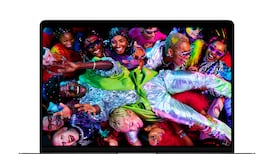When Apple unveiled its new iPads at an event in May, there was a small surprise: it added a larger iPad Air to the line-up. The company has been bringing the design of its tablets in line with each other over the past few years, so much so that it’s getting increasingly difficult to tell them apart at first glance. The latest development has closed the gap even more, giving you a 13 inch screen for the iPad Air alongside the 11-inch version. And while the new Pro has been slimmed down to be thinner than its stablemate, the iPad Air remains a sleek device that can be easily carried around in place of a laptop.
There is a lot to like about the iPad Air. The new device is powered by the M2 chip, instead of the 2024 Pro’s M4, but it is still powerful enough to carry out most of the tasks that the average user would ask of it. For the duration of this review, that means word processing, audio editing, some minor video and photo editing and a lot of video streaming. Throw in some gaming and the Air is a decent all-rounder.
At times I forget it is the Air I am using; only when trying to unlock the device do the differences become obvious. The Air uses TouchID in the power button for logging in without passwords; the Pro uses FaceID, and it is a minor annoyance to have to use the fingerprint reader instead of the more seamless facial recognition.
It may be a small thing, but considering the cost of the Air – it starts at €979 for the 13in model – I feel like Apple should make the jump and upgrade the front camera.
READ MORE
The costs can mount up quickly too. Although the iPad Air starts with 128GB of space – sufficient for most people – if you want to increase that to 256GB it will cost you an additional €130. The 1TB storage will set you back a whopping €1,609. If you want to build in the option for mobile data connections, that costs an extra €170; the Pencil is a minimum of €89 and the Magic Keyboard starts at €349. That brings the total cost for the standard 13in model to more than €1,600 – a decent laptop would set you back the same.
However, add in the long battery life – about 10 hours – and the portability, and the iPad Air wins every time over my laptop. I know which I’d prefer to have to carry around for a conference at the very least.
And that is where Apple is leading us: a laptop-less future. We aren’t quite there yet, but that is mainly down to the software.
The question is, where does the iPad Air fit now? That depends on what you want the iPad to do for you, and crucially, the budget you have at your disposal.
Advanced audio is the iPad Pro’s specialty; the iPad Air, however, is still no slouch at reproducing sound
Want powerful graphics rendering? The iPad Pro. Want to watch Netflix on a bigger screen? The iPad Air will suffice. Want to do the latter, but with a tighter budget? Then the standard – and cheaper – iPad is your best option.
Advanced audio is the iPad Pro’s speciality; the iPad Air, however, is still no slouch at reproducing sound. The additional screen space means they are neck and neck when it comes to space for multitasking, although both are still limited by the current iPad software. Both iPad Air and Pro will also work with Apple’s incoming Apple Intelligence features (when they launch here) but the A14-powered standard iPad will not.
The bottom line: the Air will give you Pro-like features at a mid-range price, with the different screen sizes filling the final gap. Unless you need the extra power that the Pro provides, Apple’s iPad Air is a good middle-of-the-road choice.
Good
Bigger screen is great, giving you extra space for watching video content or multitasking. The movement of the camera to the landscape edge of the device makes more sense – no more awkward angles when using the device for video calls. It also supports Apple’s latest Pencil Pro, which gives you more options for creative content, such as the motion sensitive barrel roll.
Bad
It may be cheaper than the iPad Pro, but it’s still pricey. Although it works with Apple’s newer accessories, it doesn’t support the Apple Pencil 2, and you will have to get the USB C version or shell out for the more expensive Pro stylus. Nano glass is a pro-only feature, but it’s not a deal-breaker.
Everything else
Base storage starts from 128GB, so you have more space for all those videos. The addition of the Magic Keyboard makes it a better candidate to replace your laptop day to day for most things. The Air still uses TouchID, as the camera isn’t up to the standard for FaceID.
Verdict
If you have Pro ambitions without the budget, the iPad Air is the next best thing.














